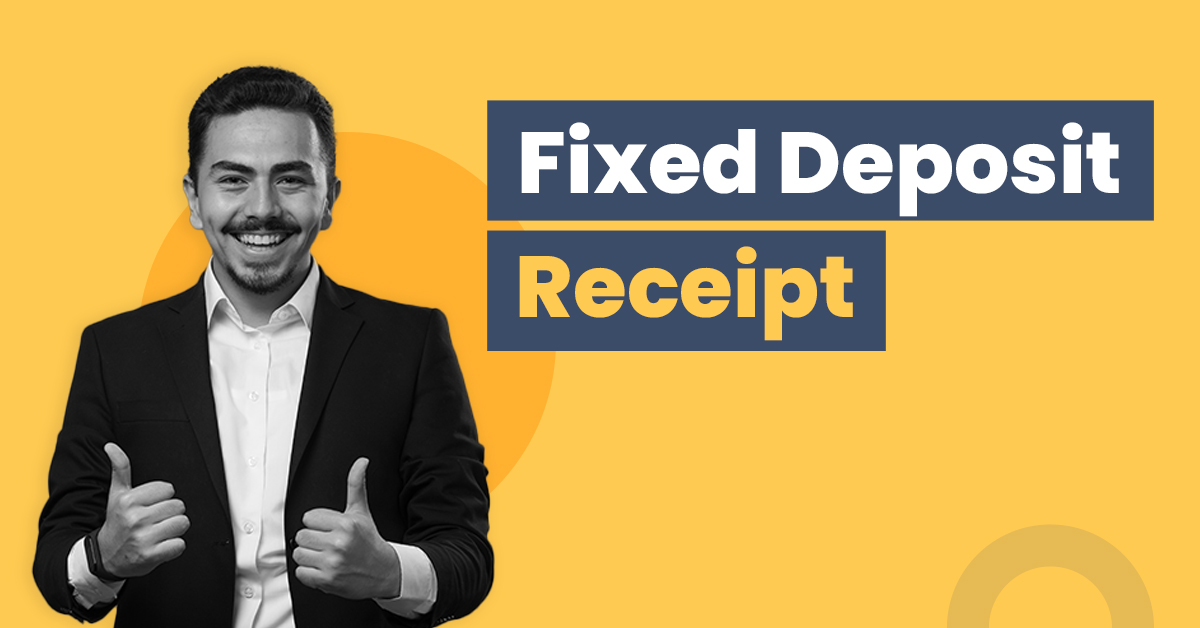Understanding Fixed Deposit Receipt (FDR): Meaning, Format, Components


If you’re considering a secure avenue for investment with assured returns, the fixed deposit receipt (FDR) often tops the list. Commonly associated with banks, NBFCs, and Post Offices, this instrument safeguards your principal amount and offers a steady interest, usually ranging between 5% to 6% per annum. While you might not achieve rapid wealth accumulation through FDRs, they are an excellent option for capital protection and stashing emergency funds.
Notably, once you invest in such deposits, institutions like ICICI Bank or SBI furnish you with a specific document termed the “Fixed Deposit Receipt”, sometimes referred to as “Fixed Deposit Advice (FDA)” or “Term Deposit Receipt (TDR).”
This document likened to a savings account’s passbook, authenticates your investment. Whether you’re eyeing a standard fixed deposit receipt format, its PDF version, or details like the FDR number in fixed deposits, it’s vital to understand the essence of this instrument.
What is FDR — Fixed Deposit Receipt?
When you purchase clothes from a store, the shopkeeper gives you an invoice or receipt. This receipt acts as proof of purchase from that store. It contains details about size, return policy, barcode number, etc. Similarly, financial institutions give you an FD receipt to acknowledge that you opened an FD account with them. A Fixed Deposit Receipt (FDR) is a document given to the investor by the bank, NBFC, or Post Office after investing in an FD. It acts as proof of investment in the FD.
Fixed deposit receipts contain various details, such as tenure, interest rate, maturity date, etc. The FDR has all the details of your fixed deposit account and is significant in many aspects.
We will go through each aspect of FDR, such as its components, the purposes it serves, and things to look out for when accepting an FDR.
Also Read: Experience financial growth with unmatched Bajaj Finance FD Rates
Components of a Fixed Deposit Receipt
Name, age, and address of the investor
An FDR will contain your full name and age as mentioned in your Aadhaar or PAN Card. Further, FDR will also state your address based on the identity proof you have provided.
Rate of interest and tenure
The interest rate offered by the financial institution, which may vary depending on the tenure of the fixed deposit and the bank you have chosen, will be mentioned in the FDR. The tenure for which you wish to invest the amount will also be mentioned. You can select the tenure while filling up the application for the fixed deposit.
Bank account details of the investor
An FDR will contain the investor’s account number and customer ID. Banks, NBFCs, and post offices provide these details after the successful completion of an FD account opening.
Maturity date and value
The maturity date and amount, i.e., the date on which the tenure of the FD ends and the amount you get after maturity, are mentioned in the FDR. Further, the document also states the interest amount you will be receiving.
Auto-renewals
Several financial institutions provide auto-renewal options. You need to check the timeframe within which you can withdraw your deposit after the maturity date. Your FD will renew automatically for the same tenure if you do not withdraw the deposit within the stipulated period. The details regarding auto-renewal are given in the fixed deposit receipt.
Deposit amount and value date
The deposit amount is the investment you made in the FD. The value date is the start date of your FD. These details are also mentioned in the FDR.
Deposit type
There are two deposit types — cumulative and non-cumulative. In a cumulative FD, the interest earned in a given financial year is reinvested and the compounded amount then earns the interest. However, in the case of a non-cumulative deposit, you receive periodic interest payments in your savings account and there is no compounding.
You can choose the deposit type while filling up the application form for the fixed deposit. The type you select will be mentioned in the FDR.
Nomination facility
An investor can nominate a person while opening an FD account. This nominee receives the amount in case of the untimely death of the investor. Every bank, NBFC, and post office provides this nomination facility. The nominee details are to be submitted while filling out the application form for opening an FD account. These nomination details are also mentioned on the FDR.
Penalty charges
If you need funds urgently and opt for premature withdrawal of funds before the maturity date, you may need to pay a penalty. These terms of premature withdrawal and details of the penalty applicable are also mentioned in the FDR.
The fixed deposit receipt format may differ for each organisation, but all the above components will surely be mentioned.
Uses And Importance of FDR
The Fixed Deposit Receipt (FDR) is not just a document certifying your investment; it plays a pivotal role in various financial scenarios. Here’s a breakdown of its importance and associated uses:
Renewal and its Use:
- Importance: If you initiated an offline FD, the bank typically requires the FDR during renewal post-maturity. To change the tenure upon maturity, surrendering the current FDR is mandatory.
- Use: Facilitates the seamless continuation of your investment, ensuring that the renewed FD is aligned with your current financial objectives.
Premature Withdrawal and its Use:
- Importance: The FDR stands as a testament to ownership for emergencies leading to early withdrawal before the maturity date.
- Use: Enables you to access your funds promptly without unnecessary delays or complications, ensuring liquidity during urgent situations.
Availing Loans and its Use:
- Importance: FDs aren’t just static investments; they can act as collateral. Many institutions offer loans against FDs at preferential interest rates. However, submission of the FD receipt becomes a prerequisite.
- Use: Empowers you to leverage your FD for immediate financial needs, making it a dual-purpose tool—both as an investment and collateral.
Things to Check in your FD Receipt FDR
To err is human. There could be mistakes while filling the form or generating the FDR. Therefore, checking that all the details are correctly mentioned on the Fixed Deposit Receipt is crucial. So, do check the following details on your FDR:
Deposit Tenure
The tenure or investment you selected must be mentioned correctly in the FDR.
Rate of Interest
Cross-checking the rate of interest is one of the most important things to do. The rate of interest remains the same throughout the tenure of the fixed deposit (except for some recently launched products by some private banks). However, at the time of renewal, the bank may change the interest rates on FDs. So, make sure whether the rate of interest is the same or has changed.
Maturity Date
You must check the maturity date mentioned in the FDR as it helps you access your deposit at the right time. If you are planning a trip or purchasing a gift for someone with your FD’s maturity amount, knowing the date of maturity will make sure you have funds at the right time.
Auto-Renewal
If you opt for auto-renewal, the details will be mentioned. If not, you must visit the bank on or after the maturity date to renew or withdraw.
Prepayment Penalty
The terms of the prepayment penalty will be mentioned on FDR. You must check those terms because you may need to withdraw the deposit before the maturity date. Usually, the bank may allow you to withdraw funds at a 1% lesser rate of interest than the predetermined rate. However, the terms regarding penalty vary from bank to bank. NBFCs and post offices have their own terms regarding prepayment penalties. So, you need to check those terms carefully.
Nominee Details
You must check whether the nomination details you mentioned while filling out the FD account opening form are correctly mentioned in the FDR. In case of the unforeseen demise of the investor, the nominee receives the amount.
Final Thoughts
The FDR in banking is the most critical document for an FD account. Without this half-page document, there is no proof of your investment, and there is no way to withdraw your deposit or avail a loan against the FD. The way a payment receipt acts as proof of purchase after shopping in a clothing store, an FDR acts as a receipt of your deposit in the financial institution. Once you open an FD account with a bank, NBFC, or post office, ensure that you get a fixed deposit receipt with all the details mentioned correctly. You must keep it safe until you close the FD account.
FAQs:
What is the process to get the payment if the FDR is lost or misplaced?
The process to get the payment if the FDR is lost or misplaced varies from bank to bank. Generally, you must submit an application containing all the details, along with the necessary documents asked by the bank. You can also request a duplicate receipt. It is advisable to visit the nearest branch and ask for assistance from the representatives there.
What is the process to get a duplicate fixed deposit receipt?
You need to visit the nearest branch of the bank where you opened the FD account and ask for assistance. You may need to submit a written application with all the details. Some banks also ask for an indemnity bond and a fee for providing a duplicate FDR. Please submit the necessary documents and pay the fee, if required, to get a duplicate FDR.
How to identify a fake FD receipt?
There are many instances when a fake FD receipt is generated and provided to investors or depositors. To identify a fake FD receipt, you can ask for the bank’s FDR format or download a fixed deposit receipt format pdf from the bank’s website and compare it with the FDR you received.
Do FDRs include information on tax declarations?
The interest earned through FD is fully taxable, so the information regarding tax declarations is mentioned in the FDR. No tax is deducted for persons submitting Form 15H / 15G.
What are the different benefits of opening a fixed deposit account?
Opening a fixed deposit account offers numerous benefits. These benefits include:
1. Flexibility of choosing the tenure and deposit amount.
2. Safe investment and guaranteed returns as returns on FDs are not market-dependent.
3. Multiple options for interest payout, such as monthly, quarterly, half-yearly or annually.
4. Ease in liquidity, as you can withdraw the deposit whenever you want. The terms for withdrawal are not as stringent as other investment options.
5. Availability of nomination facility.
6. Higher interest rate for senior citizens (people over 60 years of age).
How do I get a fixed deposit receipt?
To get a fixed deposit receipt, visit your bank or financial institution where the FD was initiated and request one.
How do I get my FD receipt online?
You can obtain your FD receipt online by logging into your bank’s internet banking portal and navigating to the FD section.
Does the fixed deposit receipt provide information related to nomination?
Yes, the fixed deposit receipt typically includes information regarding the nomination.
When applicants obtain a fixed deposit, do they receive any tax benefits?
When investing in a fixed deposit, applicants can avail of tax benefits under Section 80C up to a limit.
What are the benefits of a fixed deposit receipt?
The benefits of a fixed deposit receipt include proof of investment, details of tenure and interest rate, and facilitating renewals or loans against the FD.




